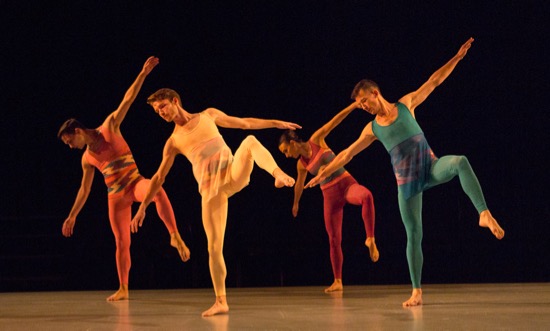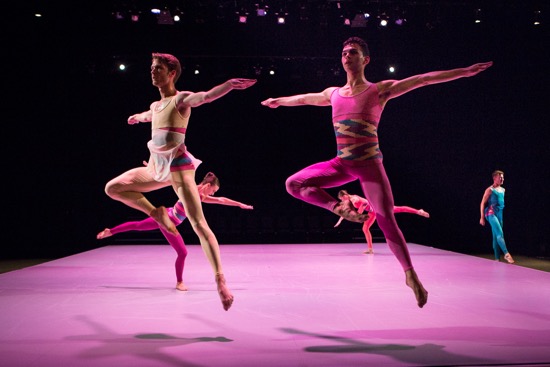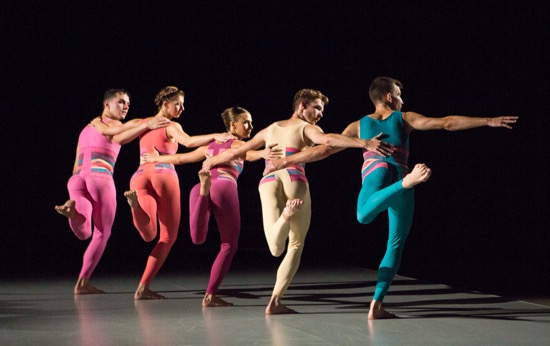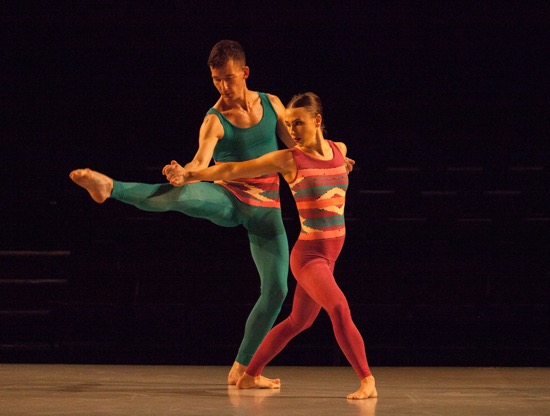Pam Tanowitz Dance kicks off “NY Quadrille,” a two-week season masterminded by Lar Lubovitch.

Pam Tanowitz’s Sequenzas in Quadrilles. (L to R): Victor Lozano, Jason Collins, Sarah Haarmann, and Dylan Crossman. Photo: Yi-Chun Wu
Over the years, dance has acquired a reputation for mysteriousness. This vexes many people, enchants others, and confuses others still more. After seeing Pam Tanowitz’s Sequenzas in Quadrilles at the Joyce Theater, I walked along the sidewalk a bit ahead of two women who were energetically discussing the work. I couldn’t make out most of their words, but did catch the fact that what they had hoped would be “something” turned out to be “nothing.” That’s the way people talk about apparitions, or ghosts.
I mention this because the experience of seeing Sequenzas in Quadrilles involved a tension among obvious facts (vibrant dancers performing for an audience), possible historical allusions, and spatial dislocations. This was both extremely pleasurable (Tanowitz is a greatly gifted dancemaker) and perplexing.
One temporary alteration in the Joyce’s mid-sized proscenium theater is admirable. For the two-week season of NY Quadrille, conceived and curated by Lar Lubovitch, a quartet of choreographers (Tanowitz, RoseAnne Spradlin, Tere O’Connor, and Loni Landon) created (or adapted) pieces for a transformed space. Half the audience sits in rows at the back of the stage; between them and those in the usual seats, a sky-blue dancing platform hovers, using up the front half of the stage and the space for the first few rows of the usual seating (the design is Lubovitch’s).
Another mystery: We’re not given programs until we’re leaving the theater. What message is being delivered? That leafing through them might disturb the atmosphere? Cause problems for ushers coping with a sudden influx (the tickets are general admission)? Tell us some secret we shouldn’t know in advance (such as the dancers’ names)?
We do receive, however (or I did—maybe it was only for the press), a small, brown envelope labeled “Scenery in Quadrilles” (designed by Suzanne Bocanegra). The six sepia picture-cards within consist of duplicate photos of a 19th-century painting of a hollow oak tree, a backdrop for the ballet Giselle, two photographs of sea and clouds, and a photo of the Ballet Russe de Monte Carlo in Les Sylphides (perhaps this counts as four?). Each of three images is slightly or almost completely covered by a colored square(s): a red, a red and a yellow, a green.
Whether or not I understand it, I like the little gift a lot. And I realize that the patches of color refer to the patches of light which lighting designer Davison Scandrett causes to appear at various time on the stage floor. It has also been suggested that, were the work to be performed on a proscenium stage, they could have the cards’ images as backdrops.

Jason Collins (L) and Victor Lorenzo in the air; at back (L to R): Sarah Haarmann, Lindsey Jones, and Dylan Crossman. Photo: Yi-Chun Wu
The title—apparently clear enough—presents another enigma. In an 18th or early 19th-century quadrille, four couples danced four to six contradances in a square formation. Tanowitz initially assembles four dancers on the square (or slightly rectangular) floor, but Victor Lozano soon joins Jason Collins, Dylan Crossman, Sarah Haarmann, and Lindsey Jones. Reid Barthelme and Harriet Jung have costumed them in diverse bright-colored unitards with a broad band around the waist bearing jagged patterns that evoke American Indian ones; the five may also don or discard matching translucent tunics. After some time, during which we’ve become ethralled by all that these virtuosos dancers can do, Christine Flores in comes to join them. Another mystery: Her name appears in the program only as “understudy.” She is clad all in white, and, if you scan a photo of her closely, you can see that her costume is a model for those of the others; a few written directions and dotted lines that indicate cuts scar its surfaces. This small, spry person never stays long; she makes only three or so visits but is with the others in the end, when their world goes dark.
There are also five musicians of The Knights collective on view, but they play primarily alone and separated in space. Periods of silence stud the work, and some time passes before Max Mandel, seated in the balcony closest to the right corner of the stage, plays Luciano Berio’s fiercely simmering Sequenza for Viola. Shortly, Dave Nelson appears to replace him on the opposite side of the house, playing Berio’s Sequenza for Trombone. Quite a bit later, cellist Hannah Collins and percussionist Michael Compitello deliver David Lang’s Stuttered Chants from behind the audience on the left of the theater. Bridget Kirby interrupts that, playing Berio’s Sequenza for Harp from the right rear of the theater. So they enclose us in a square too, and we have to twist and crane to be sure of their presence.
The ghosts of composer John Cage (who also in certain instances scattered musicians around a theater) and Merce Cunningham hover over this endeavor. Tanowitz’s demanding movement is reminiscent of Cunningham’s. The dancers are in control, their feet busy with fast steps, their bodies primarily erect or calculatedly bent, their arms placed (or whipped) into positions. There are few loose ends. These experts point their feet or pointedly flex them. They turn out their legs much of the time. If you were of a mind to discern relevés, passés, chassés, sautés, and assemblés, you could do that, but Tanowitz’s steps resemble these only in their basic shape and certainly not in style or context.

Pam Tanowitz’s Sequenzas in Quadrilles. (L to R): Victor Lozano, Lindsey Jones, Sarah Haarmann, Jason Collins, and Dylan Crossman. Photo: Yi-Chun Wu
Her choreography is full of surprises—odd maneuvers, rhythmic variations, and changes of direction that reward the opposing banks of spectators. Say Crossman wants to stand still and wheel his arms around for a while; that’s fine. So is dropping to the floor and reclining for a while. So is fluttering one’s hands. The overall performing dynamic of the piece is one of “let me try this” or “I need to work/play at this for a while.” One conspicuous and, to me, very powerful aspect of this is the dancers’ attention to one another and to their task of the moment. Like players in an intricate board game, they are watchful. They may pause, wait, spatter into activity, then focus on a single move. The hyper-awareness may be due, in part, to their taking cues from one another, but it humanizes them in a way that contributes to the atmosphere of the piece. When Flores threads her way along a hand-holding line the others have formed, the others turn their heads to track her progress.
You don’t follow their activities the way you would those in a competitive game, nor do you try to discern their motives or predict what comes next. The three men gather around Haarmann and efficiently pick her up and hold her overhead horizontally; she’s arched back, her bent legs slightly apart and her arms forward (sort of like a tipped-over runner frozen in mid-air). Bearing her like this, they don’t just walk simply; every few steps, they bend one knee or flick a foot. Then they put her down and get on with other business.
Every move they make seems deliberate; no storms, internal or external, buffet these terrific performers about. Just once, I saw two of them sag briefly, although even that was controlled. Yet everything they do evokes human behavior or raises questions about it. One sequence ends with Jones sitting on the floor with her long legs spread very wide apart. Lozado and Collins pick her up in that position, carry her to a new spot, and set her down again. This maneuver happens several times in a row, with Jones turning her head as if to indicate where they should place her. The combination of gentility, even regality, contrasts with her awkward, exposed position. At the end of this sequence, Flores makes her briefest appearance, jumps over Jones’s outspread legs, and exits.

Dylan Crossman and Sarah Haarmann in Pam Tanowitz’s Sequenzas in Quadrilles. Photo: Yi-Chun Wu
Another time, Crossman and Haarmann lie on the floor some distance from each other and, to jerky music by viola and light percussion, roll a bit closer together, re-positioning their resting poses, then rolling closer still. Finally, she rolls onto him, and a pale spotlight from above illumines them. When the music stops, she rolls away, and he exits, hitting one foot against the floor as he goes. Then the harp raises its mellow, rippling voice, and Crossman re-enters to take part in a male trio, in which all three men are busy with different strenuous (and gorgeous) tasks. One of Lozano’s is to circle the others with a springy mazurka step (this is the section in which Crossman whirls his arms). Eventually, those two roll away, and Collins, in a short solo, reminds me that one of the silent questions the dancers occasionally seem to be asking is “what am I hearing?”
Tanowitz helps us notice all these splendid performers—whether they’re alone, as in two especially marvelous, variegated solos for Crossman and for Haarmann; or together in unison passages; or on their own in masterfully designed canons. The choreography is also highly articulate and changeable within its density and appointed range. The dancers cover ground athletically or find a place and stitch a lot of fast, intricate steps onto it. They slow down and execute a single move as if intent on only that action. They’re in the air, they’re on the floor. Now they spin, now they pursue straight paths.
You sense the end is coming when all the light rectangles that have appeared previously, one at a time, reappear together on the floor. The dancers link themselves together in a horizontal line, and slowly lift a leg as they step and turn to face both banks of spectators. Flores, the last to join the line, enters, and the lights change to low-level white, so that the performers’ long, skinny shadows slip along the floor. Slowly and not in perfect synchrony, they lie down together, and the lights dim to black.
Enigmas etched with perfect lucidity.
Pam Tanowitz Dance has two more performances on Saturday, October 1. The other three in NY Quadrille are scheduled as follows: RoseAnne Spradlin: September 29, 30, October 2 (matinee and evening); Tere O’Connor Dance: October 4, 5, and 8 (matinee and evening); Loni Landon Dance Project: October 6, 7, and 9 (matinee and evening).

Thank you for your insightful review . Always a pleasure to access your mind. One correction: the stage is designed by me, not Ms Bocanegra ( she designed the ” scenery” contained in the envelope you mentioned).
I originally designed it for a piece of my own at the Joyce but subsequently decided not to do it . The Joyce however expressed great interest in the idea and asked if i could conceive of another way to utilize it . I came back with NY Quadrille which they generously and whole-heartedly embraced.
I’m grateful to Lar Lubovitch for the correction. I have, accordingly, updated the posted review